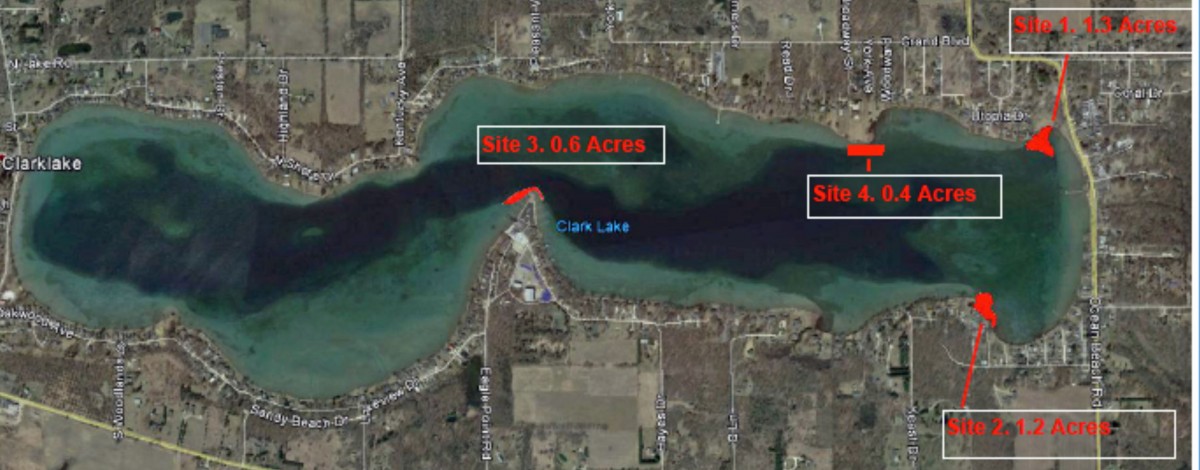As readers of this website have learned, DNA evidence confirms the presence of hybrid Eurasian water milfoil (HEWM) in Clark Lake. If unchecked, this invader spreads quickly. This can result in the destroying of natural habitat, curtailing recreational uses of the lake (like boating, swimming and fishing), and threatening property values. The Clark Lake Invasive Species Committee has formed to deal with the problem.
Four HEWM sites have been targeted for this spring. John Deming, Committee chairman, says “the DEQ has issued a permit” for these sites and that “a tentative schedule will arrive shortly.” Land owners in the affected areas have already given their assent for the treatment in the offshore area in line with their property. Those affected will soon receive schedule information and will also be reported on this website. The work will be performed by Professional Lake Management, also known as PLM.
The cost of the four treatments this year are being covered by donations. The Clark Lake Spirit Foundation is receiving donations on behalf of the committee and disbursing funds to cover the expenses. Donations to the Foundation are tax advantaged.
The four treatments scheduled for this year cover only a portion of the 20 acres of HEWM in the lake. Given the tendency of this invasive weed to spread rapidly, why not treat all 20 acres this year?
Here’s the explanation:
The 2015 areas of treatment are only possible with the permission of lakefront landowners in an area determined by their property lines extending out into the lake, but not to exceed 250 feet from the shore. These are called “riparian rights.” The reason for the 250 foot limit is that it’s difficult or impossible to determine the riparian rights beyond that point. The extended property lines begin to cross and/or converge creating an undecipherable spider web.
As noted above, the 2015 treatment will affect only a fraction of the infestation. Making treatment permissible wherever needed is something called a Special Assessment District (SAD), but this takes time. Members of the Committee have been working with Columbia Township officials to create a Clark Lake SAD to enable treatment by 2016. In addition to making possible treatment wherever needed, the SAD will have the ability to finance the work by collecting funds as an add-on to property taxes. A current estimate of annual cost to each lakefront landowner is not expected to exceed $100. The experience of other lakes has shown that after the initial year of treatment, the cost can decline significantly. A recent news article tells the story of some nearby lakes.
There are several steps to establishing the SAD. The Committee will be asking lakefront owners to sign a petition to present to the Columbia Township trustees. There will be two public hearings with published notices. Once the SAD is approved and created by the Township, treatment can be scheduled. Current plans call for a seven year “life” for the SAD. It can be renewed after that, if needed.
Below are two photos from the air of the same area–in front of the County Park at the east end. The first photo was taken in 2013; the second, in 2014. Note the increase of HEWM in this area. (Scroll beyond photos for more story).
The Committee held a public information in December. A straw vote was taken to ascertain whether the 89 people attending favored the direction of the Committee. The nearly unanimous vote supported the Committee’s analysis and plan. One person who has been at Clark Lake for all 70 of his years, commented: “I don’t relish the idea of herbicides in the lake, but after hearing the pros and cons, I think this is the only way to move forward. I do not want us to lose the lake we’ve always known. Therefore I’m supporting the current direction of the Committee.” Observers in the audience noted that heads nodded in agreement.
Other lakes in our region have faced their own struggle with HEWM. There is a kernel of good news in that. Clark Lake does not have to “reinvent the wheel.” The residents and Committee can learn from the experience of others. The approach outlined by the Committee draws greatly on these experiences.













